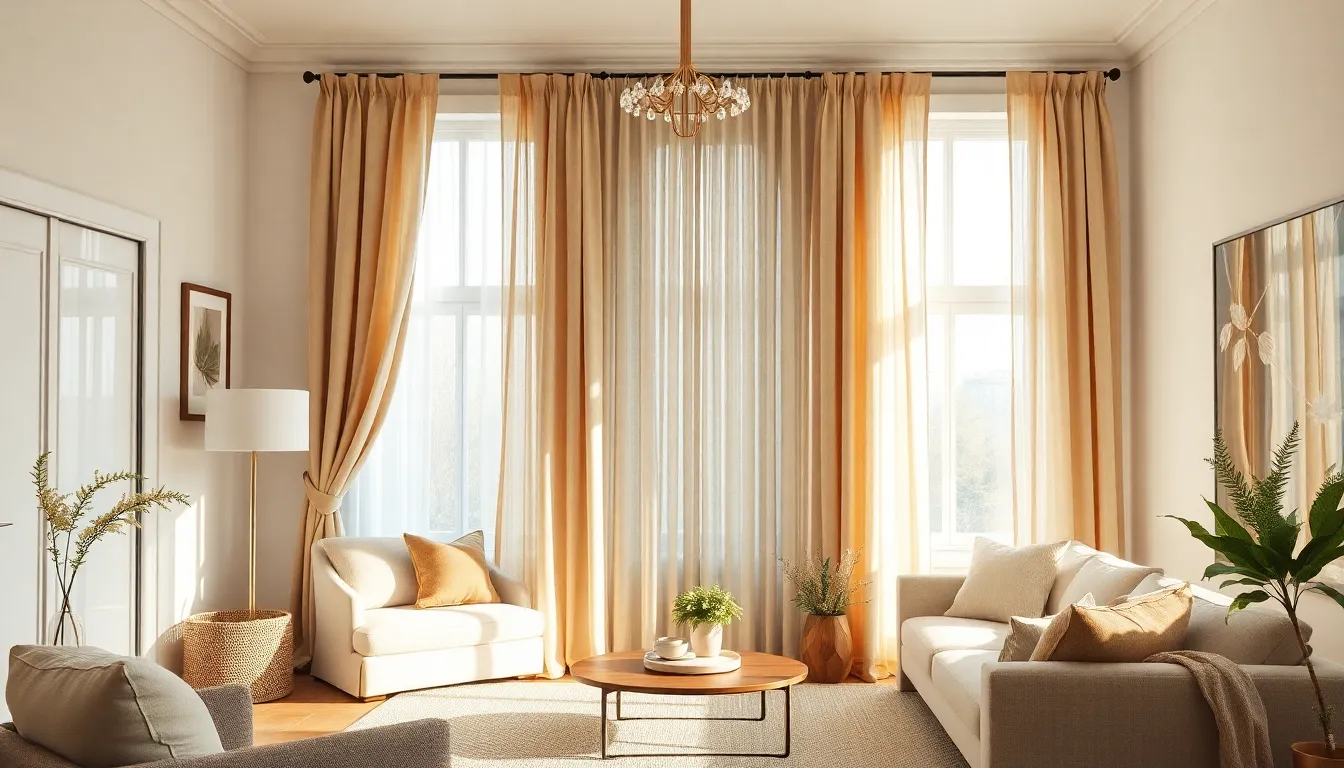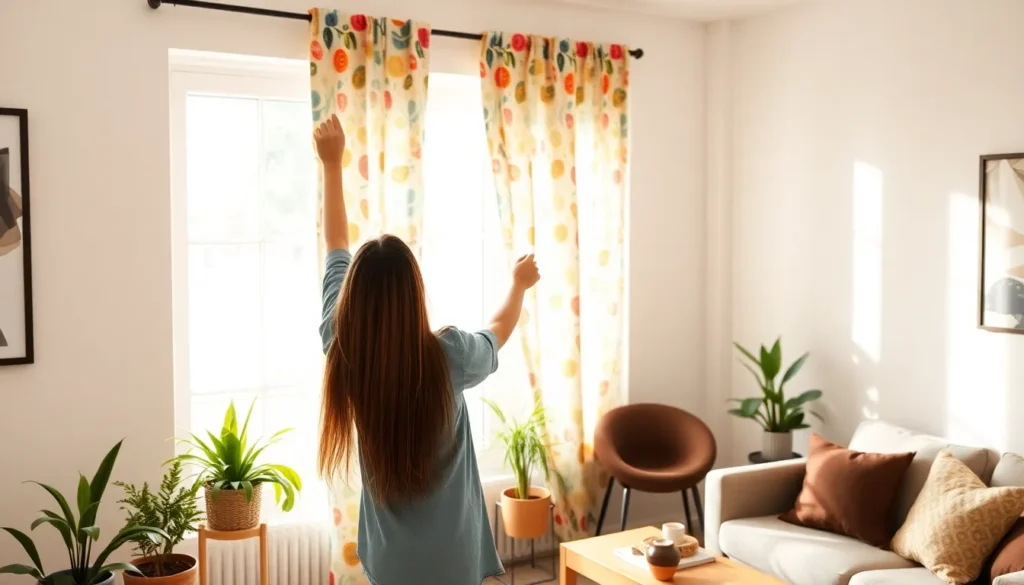Table of Contents
ToggleTransforming a room doesn’t always require a hefty budget or a professional designer. Sometimes all it takes is a little creativity and a few DIY curtain ideas to breathe new life into a space. Whether it’s a cozy living room or a chic bedroom, the right curtains can make all the difference. Plus, who doesn’t love the satisfaction of saying, “I made that!” while sipping coffee in their newly adorned sanctuary?
Creative DIY Curtain Ideas
Creating unique curtains offers an opportunity to personalize any space. Use fabric paint to add patterns or designs to plain curtains, giving them a custom look. Opt for reclaimed wood to construct a curtain rod, adding rustic charm to a room.
Incorporate lace or burlap for a textured effect, blending vintage and modern styles seamlessly. Experiment with multiple fabric layers, using different lengths for a playful atmosphere.
Frame windows with fabric tiebacks fashioned from leftover material or ribbon, enhancing the visual appeal of the drapes. Choose clip rings to hang fabric panels, allowing for easy adjustability and a contemporary flair.
Utilize tension rods in unconventional locations, such as closets or nooks, to create hidden spaces with character. For a touch of whimsy, transform a tablecloth into a vibrant curtain, combining functionality with creativity.
Add trim or tassels along the edges of existing curtains, introducing additional color and texture.
Select fabric from thrift stores, maximizing budget by finding unique patterns or colors. Create a no-sew curtain by using fabric glue to hem edges for an effortless project.
Combine sheer and opaque fabrics for a layered effect that plays with light while maintaining privacy. Craft a curtain from a shower curtain to bring a playful vibe to a child’s room or bathroom.
Incorporate stencils to create custom designs on fabric, giving an artistic flair that matches personal style. Each method offers a way to refresh a living space, demonstrating that creativity knows no bounds in DIY projects.
Types of Fabrics for Curtains

Selecting the right fabric plays a crucial role in creating beautiful curtains that enhances any room’s aesthetic. Various options exist, catering to different styles and purposes.
Natural Fabrics
Cotton offers breathability, making it a popular choice for casual curtains. Linen provides an elegant look with its natural texture and drape. Silk is luxurious, known for its rich sheen and soft touch. Wool serves well for heavy drapery, delivering warmth and insulation. Each natural fabric also comes with its own care requirements, requiring attention during cleaning to maintain quality.
Synthetic Fabrics
Polyester stands out for its durability and resistance to wrinkles, making it suitable for high-traffic areas. Nylon is lightweight and often used for sheer curtains, allowing light to filter through gently. Acrylic mimics wool’s texture while being easier to clean and care for. Blends offer versatile options, combining the benefits of synthetic and natural fabrics for a unique approach. These synthetic choices provide practical solutions without sacrificing style.
How to Choose the Right Curtain Style
Choosing the right curtain style greatly influences a room’s atmosphere and functionality. Various factors come into play, including the overall decor, personal preference, and purpose of the curtains.
Casual vs. Formal
Casual curtains bring a relaxed vibe to living spaces. Lightweight fabrics like cotton or linen work well for a laid-back ambiance. Formal curtains project sophistication and elegance. Rich fabrics such as silk or velvet enhance formal settings. A simple rule applies: match the style of the curtains to the room’s purpose. Consider using tailored drapes for dining rooms or elaborate patterns for more casual areas like bedrooms or playrooms. Eye-catching hardware can elevate both styles, contributing to a cohesive design.
Patterns and Colors
Patterns and colors set the mood of a room. Bold patterns infuse energy and personality into spaces. Selecting floral prints, geometric designs, or stripes adds visual interest. Conversely, solid colors provide simplicity and elegance, allowing for easy pairing with other decor. Neutral tones complement any style, while vibrant hues can make strong statements. When mixing patterns, balance is key. Use similar color palettes or match designs for harmony. Testing fabric swatches in the room’s lighting ensures the chosen colors enhance the overall aesthetic.
Step-by-Step DIY Curtain Projects
DIY curtain projects enable individuals to express creativity while enhancing their living spaces. Here are two popular options to consider.
Simple Rod Pocket Curtains
Rod pocket curtains offer an easy way to achieve a classic look. First, measure the window and cut fabric to desired length and width. After cutting the fabric, fold the top edge over by 3 inches, creating a pocket for the curtain rod. Use a sewing machine or fabric adhesive to secure the fold in place. Next, slide the curtain rod through the pocket before hanging it on brackets. This straightforward method allows for easy installation and effortless movement of the curtains. Experimenting with various fabrics, such as cotton or linen, can add texture and interest to any room.
No-Sew Curtains
No-sew curtains provide a budget-friendly option for quick home updates. Begin by measuring the window area and cutting fabric accordingly, ensuring a minimum of 2 inches extra for the hem. Use fabric glue to secure the hem, preventing fraying while providing a polished finish. Additionally, adhesive tape can attach fabric to a curtain rod without sewing. For added convenience, clip rings easily connect to the fabric, allowing for smooth movement. By employing this method, individuals save time and effort, achieving stylish results with minimal tools and supplies. Consider adding embellishments like ribbons or tassels for personalized flair.
Tips for Hanging and Styling Curtains
Selecting the right location for hanging curtains can dramatically influence a room’s appearance. Eye-level placement is crucial. Most commonly, hanging curtains 84 to 96 inches above the floor creates an illusion of height, making the space feel larger.
Utilizing two panels per window enhances symmetry and visual appeal. A matching pair balances the decor, creating a polished look. Mixing textures adds interest; combining sheer fabrics with heavier materials like velvet produces depth and elegance.
Using curtain clips allows for effortless adjustments. Simply slide the panels along the rod for easy opening and closing. Layering curtains also increases versatility; for example, sheer panels can filter light while blackout curtains provide privacy.
Tiebacks serve both functional and decorative purposes. Employing fabric or rope tiebacks keeps curtains neatly drawn to the sides, framing the view. Choosing decorative hardware elevates the overall style. Opting for wooden or metallic rods complements various decor themes.
Consider the color scheme in the room when selecting curtain colors. A bold hue can act as a focal point, while neutral tones create a calm backdrop. Testing swatches near the window helps visualize how different fabrics interact with natural light.
For an added touch, decorative elements like tassels or trims can enhance the curtain’s appeal. Attaching these accents not only personalizes the look but also adds sophistication. Using a mix of patterns can energize the space; however, maintaining a consistent color palette ensures harmony within the room.
Finally, adjust curtain lengths based on the desired effect; floor-length curtains evoke drama, while sill-length options lend a casual charm. Prioritizing these tips leads to a beautifully styled and functional window treatment.
DIY curtain projects offer an exciting way to personalize and enhance living spaces. By exploring creative ideas and experimenting with various materials and styles, anyone can transform a room on a budget. The satisfaction of crafting unique curtains not only elevates home decor but also reflects individual taste and creativity.
Whether opting for no-sew methods or traditional sewing techniques, the possibilities are endless. Incorporating different textures and colors can create a dynamic atmosphere that suits any room’s purpose. With a little imagination and effort, DIY curtains can be both functional and stylish, making them a rewarding addition to any home.



